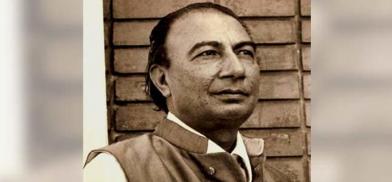An icon of South Asia: Sahir Ludhianvi’s lifetime work and legacy still relevant
Sahir's birth centenary, on March 8, 2021, is an occasion for all to revisit his lifetime work and legacy that has tremendous relevance even in our own troubled, testing times, writes Venkat Parsa for South Asia Monitor

Sahir Ludhianvi is an icon, not just of India, but for the whole of South Asia. Sahir personified the common cultural and civilizational ethos that binds together the whole of South Asia.
Sahir's birth centenary, on March 8, 2021, is an occasion for all to revisit his lifetime work and legacy that has tremendous relevance even in our own troubled, testing times.
Born Abdul Hayee, he went on to acquire the pen-name, Sahir Ludhianvi, and became a legend in his own lifetime.
At the age of 19, he composed the nazm on the Taj Mahal, which created waves. Taj tere liye, ek mazhar-e-ulfat hi sahi, Tum ko is vaadi-e-rangeen se aqeedat hi sahi, Meri Mehboob kahin aur mila kar mujh se (Taj may be a Symbol of Love for you, You may have Faith in this Monument of Love, My Beloved, still, let us meet elsewhere). Taj, a universal symbol of love and faith was, for Sahir, a symbol of exploitation by an emperor, who, on the strength of his wealth, sought to mock at the poor.
Talqhiyaan (bitterness) was the first book brought out by Sahir at the age of 23 years. Parchchaiyaan (shadows) and Quliyaat-e-Sahir (collected works) were among his other major works. A powerful lyricist, Sahir invested heavily in his film songs, raising the quality to the next level.
Cherished values
Partition impacted people of the Indian sub-continent, perhaps like no other historical event did. Personally, Sahir lived and worked in Lahore, now in Pakistan. But, at the time of partition, he chose to move out, first to Ludhiana in Punjab, and then to Mumbai in Maharashtra, struggling hard to restart his life all over again.
The trauma of partition, however, did not shake his basic faith in the human values he cherished all through his life. Sahir saw in free India's first Prime Minister Jawaharlal Nehru a flag-bearer (alambardar) of the values of secularism, socialism and world peace.
Sahir's works reflected these values. These are the very values that Sahir articulated in his poems and songs.
Secularism shows forth through his song for the Hindi film, Dhool ka Phool (1959), ‘Tu Hindu banega na Musalmaan banega, Insaan ki aulad hai insaan banega’ (You will neither be a Hindu nor a Muslim, Son of a Human Being,You will be a Human Being). The opening stanza of the song says: ‘Achha hai abhi tak tera kuch Naam nahi hai, Tujh ko kisi Mazhab se koyee kaam nahi hai, Jis Ilm ne insaanon ko taqseem kiya hai, us Ilm ka tujh par koyee ilzaam nahi hai, Tu badle huve waqt ki pechaan banega. (It’s good you do not have a name, still, You have no need for any religion, as yet, It’s good that the Knowledge that divides people has not yet cast its shadow on you).
‘Maalik ne har insaan ko insaan banaya, Hum ne use Hindu ya Musalmaan banaya, Kudrat ne to bakshi thi hume ek hi Dharti, Hum ne kahin Bharat, kahin Iran bananaya, Jo tod de har bandh woh toofaan banega. (God has created man, we have made them, in turn, Hindu or Muslim; Nature has given us unbounded land, we have created India and Iran; You will become a force that will break all barriers).
‘Nafrat jo sikhaaye woh Dharam tera nahi hai, Insaan ko jo raunde woh kadam tera nahi hai, Qura'an na ho jis mein woh Mandir nahi tera, Gita na ho jis mein woh Haram tera nahi hai, Tu Aman ka aur Sulah ka armaan banega.’ (Your Religion is not the one that spreads Hate, Your step will not be for trampling people under your feet; Your Gita will not be one that does not allows a Mosque, Your Qura’an will not be one that does not allow a Temple, You will be the Harbinger of Peace and Harmony).
Socialism, for Sahir, was the fight against inequality and injustice and battling relentlessly for the rights and dignity of women.
Sahir's poem, used in the cult classic Pyaasa, was originally: ‘Sanaa-khwaan-e-taqdees-e-Mashriq kahaan hain, Zara mulk ke rahbaron ko bulaao, Yeh kuche, yeh galiyaan, yeh manzar dikhao.’ ( Where are the leaders of morals and ethic? Call the leaders of the nation, show them the lanes and by-lanes and these sights).
For the film song in Pyaasa, this was modified as, ‘Jinhe naaz hai Hind par woh kahaan hain. It has a line, Madad chaahti hai yeh Hawwa ki Beti, Payambar ki Ummat, Zuleikha ki Beti.’ (Where are those, who pride in India? This daughter of Eve seeks help, the commune of Prophet Mohammad, and the Zuleikha is Beti is a reference to the Epic Love of Yusuf-Zuleikha in Bengali Literature in Bangladesh).
World Peace is the theme of his major work, Parchchaiyaan (Shadows). It is a cry against the war. World War II ended on the deadly note of the nuclear holocaust. Soon in its wake, the world was polarized into two rival blocs of military alliances. With horrendous insensitivity, more lethal nuclear weapons of mass destruction were being amassed, with the potential to blow up planet earth several times over.
Sahir's Parchchaiyaan gave articulation to Nehru's ideal of world peace, secured through the Non-Aligned Movement (NAM) that sought to steer clear of bloc politics.
Parchhaiyaan is universal in its scope and appeal. It makes spirited advocacy to outlaw war as a means of settling international disputes, thus securing the ideal of world peace. India does not eye, nor does it want to snatch anyone's land. It wants to irrigate its own land and get machinery to generate employment. The Indian blood is for rearing the future generations, but not for raising armies.
It makes a veiled reference to apprehensions of nuclear war, where there will be no distinction left between the victor and the vanquished, where even the fruits of victory turn ashes in the mouth.
In earlier wars, houses were razed to the ground; next time round, even the shadows will be burnt down, is Sahir's warning.
Ghuzishta Jung mein Ghar hi jale, magar is baar, Ajab Nahin, ke yeh tanhaaiyaan bhi jal jaayen, Ghuzishta Jung mein paiker jale, magar is baar, Ajab nahin, ke yeh Parchchaiyaan bhi jal jaayen (In the previous war, only houses were gutted, but this time round, Nothing strange, if the sense of loneliness and even the shadows are burnt away).
Metaphysical strain
In ordinary film lyrics, he introduced metaphysical strain. For instance, in Na to caravaan ki talaash hai (Not in search of a caravan), a Qawwali in Barsaat ki Raat, Sahir shows up the metaphysical streak in the lyrics.
Drawing upon the composite Indian culture, Sahir’s lines here are replete with the rich Radha-Krishna imagery. Jab jab Krishna ki Bansi baaji, nikli Radha saj ke, Jaan ajaan ka dhyaan bhulaake, lok-laaj ko tajke, Haaye ban-ban doli Janak-Dulari, pahan ke prem ki mala, Darshan jal ki pyaasi Meera, pee gayi bis ka pyala, Aur phir arz kari ke laaj raakho dekho-dekho (This is a reference to the mystical love of Radha for Lord Krishna. Whenever Lord Krishna plays his flute, Radha forgets everything and roams around forests, wearing the Garland of Love. Meera, thirsting for the Nectar of Lord Krishna’s Darshan, even drinks a cup of poison. And prays to the Lord to look after her well-being).
The ultimate in lyrical poetry, allusions, and transcendent symbolism is yet to follow: Allah, Rasool ka farmaan ishq hai, Yaani Hadith ishq hai, Qura'an ishq hai, Gautam ka, aur Maseehaa ka, armaan ishq hai, Yeh kaayanaat jism hai aur jaan ishq. hai, Ishq sarmad, ishq hi mansoor hai, Ishq Moosa, ishq Koh-e-Toor hai, Khaaq ko but, aur but ko Devtaa karta hai ishq, Intahaa yeh hai ke bande ko khuda karta hai ishq. (Allah and Prophet their decree is Love, Message of the Sacred Hadith, which is a collection of traditions and sayings of Prophet Mohammad, and of the Qura’an is Love; Message of Gautam Buddha and Jesus is Love, Universe is the Body and its Life is Love; Love is Eternal and Everlasting (Sarmad), it is Defended and Protected by God (Mansoor), Love is Moses and the Mount Sinai (Koh-i-Toor) on which the Ten Commandments were revealed. Love has the power to transform Dust into Idol and Idol into God. The pinnacle is that it transforms a Devotee into God).
In his Dil Hi To Hai film song, ‘Laga chunri mein daagh chhupaon kaise, (This is a poetic reference to a damsel who seeks to hide a spot with her apron), there is a line that sums up Indian philosopher and theologian Adi Shankaracharya's philosophy: "Odhi chunariya aatma mori, Mail hai maya-jaal, Woh duniya more babul ka ghar, Yeh duniya sasuraal, Haan jaake babul se nazren milaun kaise, Ghar jaaun kaise.’ (It compares Maya with a veil that envelops the Soul, this world is compared to the girl’s parental home and the Other World to her In-Laws home and says how would the girl go and face the Creator).
It was the same, with the song in the film Chitralekha, ‘Man re, tu kaahe na dheer dhare, Oh Nirmohi, moh na jaane, kin ka moh kare." (Oh Mind, why don’t you have patience, Nature of the Soul is Free of Infatuations, why are you infatuated). A line goes, "Utna hi upkaar samajh koyee, jitna saath nibha de, Janam-Maran ka mel hai Sapna, Yeh Sapna bhikhraa de, koyee na sangh mare.’ (Whatever measure of support you get, just think that much was destined; birth again and death again is a Dream, which you must dispel).
Sahir's mastery in chaste Hindi, as opposed to the heavily Sanskritized Hindi that has been brought into vogue by the Hindu right long after Indian independence, is seen in his songs. A classic example is his song in Chitralekha, ‘Sansar se bhaage phirte ho, Bhagwan ko tum kya paaoge, Is lok ko tum apna na sake, Us lok mein bhi pachhtaoge.’ (It mocks an Ascetic who renounces the world and asks him how he will attain God; having failed to own up this world, the Ascetic will only regret in the Other World).
There is a Persian grammatical construct called izaafat, that links up compound phrases. While Urdu poet Mirza Ghalib used it extensively in his poetry, Sahir introduced it even in his film songs. In his song in the movie Taj Mahal, Sahir uses izaafat to a great extent:
‘Khuda-e-Bartar, Teri zameen par,
Zameen ki khatir yeh jung kyon hai,
Har ek fath-o-zafar ke daanan mein
Khoon-e-insaan ka daagh kyon hai.
(Oh Almighty God, on your land, why are wars waged for the land. Why is the conqueror’s victory stained by human blood).
Zameen bhi Teri hai, hum bhi Tere
Yeh milkiyat ka sawaal kya
Yeh qatl-o-khoon ka rivaaj kyon hai
Yeh rasm-e-jang-o-jadaal kya hai
Jinhe talab hai jahaan bhar ki
Unhi ka dil itna tang kyon hai
(Land is Yours, we are all Yours
Where then is the question of ownership and property
Why this tradition of Killings and Bloodshed
What is this strange tradition of beastly butchering and mindless wars
Those, who aspire to rule the whole world
Why are their hearts so narrow ?)
Qaza ke raste pe jaane waalon ko
Bach ke aane ki raah dena
Dilon ke gulshan ujad na jaaye
Mohobaton ko panaah dena
Jahaan mein jashn-e-wafaa ke badle
Yeh jashn-e-teer-o-taffang kyon hai’
(Those who tread the pathways of Death
Give them the way to come back safe
May the gardens of hearts be not destroyed
Give refuge to Love in people’s hearts
Instead of the celebration of Loyalty
Why is this celebration of Arrows and Guns)
Casting his magic spell across generations of people, he combined literary genius, with the capacity to come up with powerful lyrics. Sahir could fire the imagination of the people and sway the masses as no other poet-lyricist could ever do.
Eternal optimist
Sahir, like Nehru, was never a pessimist. Despite the grim realities of the present, Sahir always looked forward to a bright future, like in his nazm Aao Ki Koyee Haseen Khwaab Bune
‘Aao ki koyee khwaab bune kal ke vaaste
Varna yeh Raat aaj ke sangeen daur ki
Dhas legi jaan-o-dil kuch aise,
Ki jaan-o-dil taa-umr phir na
Koyee haseen khwaab bun saken’
(Come, let us weave a dream for tomorrow
Otherwise this Night of the Bitter Present
Will sting the heart and soul in such a way that
Heart and Soul will not be able even in a lifetime
To weave a dream again)
In celebrating the magical verse of Sahir, humanity must not forget how to dream.
(The writer is a veteran journalist. The views are personal)
-Notify me when new comments are added- checkbox and from now
on each time a comment is added I recieve 4 emails with the same comment.
There has to be an easy method you are able to remove me
from that service? Appreciate it!
My blog post <a href="https://youtu.be/AXn325kQj9k">the genius wave</a>
visiting this website and be updated with the newest news update
posted here.
Feel free to surf to my webpage ... prostavive - https://youtu.be/8TRZDJDnY5U










Post a Comment